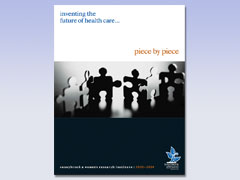Mighty Bubbles
There's a lot to catch the eye in the office of Dr. Peter Burns, a senior scientist at SWRI. There's the mass of books heaped on shelves, their spines spiked with colour. There's the sixth-floor view of sky and green pines in the distance against it. There's a vial of what looks like white powder, which wouldn't be at all interesting if it didn't hold the stuff that enables Burns and others to see blood vessels too tiny to be seen otherwise: microbubbles.
"People don't understand bubbles," says Burns, holding the vial in his hand. "They think that if you inject bubbles, you must be intending harm." This is far from the truth. Not only are the microscopic bubbles of encapsulated gas harmless, they're also useful, because they give information about the smallest of our blood vessels. For example, during a heart attack, they show where blood flow is poor. In cancer, they can show where angiogenesis, the birth of tumour-feeding vessels, is happening.
Less than a droplet of microbubbles is injected into a vein. Viewed with an ultrasound technique developed at SWRI, the bubbles look bright as they swim through the bloodstream. The tissue looks dark. This is because of the bubbles' acoustic properties. "We excite the bubbles to ring like a bell. Just as a resonant source of sound stands out, so these bubbles stand out in their acoustic surroundings," explains Burns.
Many clinical research centres are already using microbubble techniques to diagnose heart disease. And recent studies in liver cancer, a disease where early detection might mean recovery rather than death, have affirmed the method works. It can be used to guide new minimally invasive therapies and to verify that a tumour has been completely removed, all without the patient leaving the table. Furthermore, it's less expensive than other imaging methods.
An angiogenesis-tracking method Burns is refining adds more information. It helps doctors to identify benign and cancerous tumours in real time. Burns explains it using the example of watching cars travel from above. Individual cars cease to be recognizable; instead, you see arcs of brightness that illuminate their path. Because blood vessels sprout chaotically from a tumour, unlike in normal tissue, their travel appears random as viewed on a screen with this tracking method.
Looking ahead, it has other potential clinical uses, like testing the effects of antiangiogenic therapies and as a simple test in emergency rooms to see if chest pain is related to blood flow in the heart. This research is still in the translational stage. But, as Burns notes, shaking the vial slightly, this is the natural course of medical research. "You must remember that the advance of even obstetrical scans, which we now take for granted, took decades."
This work is supported by The Terry Fox Foundation and the Canadian Institutes of Health Research.
PDF / View full media release »





